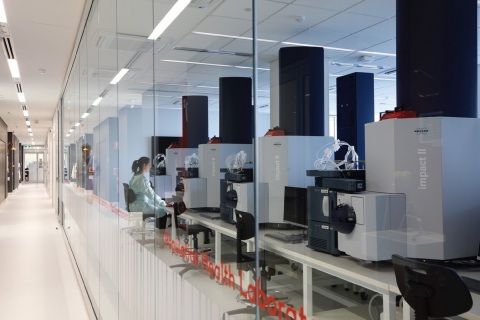Australian National Phenome Centre Integrates Quantitative NMR and MS Assay Platform for Risk Assessment and Longitudinal Monitoring of Post-Acute COVID-19 Syndrome (PACS)
A clinical research collaboration on COVID-19 pheno-conversion and subsequent pheno-reversion has discovered transient and persistent systemic changes of the molecular signatures in patient blood samples three months after the acute COVID-19 disease phase. These biochemical abnormalities, identified by a quantitative, label-free assay platform integrating nuclear magnetic resonance (NMR) spectroscopy and mass spectrometry (MS), relate to ongoing ‘long COVID’ symptoms, which persist post-acute infection and can affect more than half of the recovered COVID patients - even six months after infection.
This press release features multimedia. View the full release here: https://www.businesswire.com/news/home/20210520005741/en/

ANPC impact II QTOF-MS Lab (Photo: Business Wire)
A series of seminal papers on the molecular phenome of acute disease and post-acute COVID syndrome in patient plasma has been announced (https://medicalxpress.com/news/2021-05-covid-affecting-patients-months.html) and published (1-5) by the Australian National Phenome Centre (ANPC) at Murdoch University, in collaboration with other academic medical centers, and with Bruker Corporation (Nasdaq: BRKR) as a key technology partner.
The integrated, quantitative NMR and MS assay platform, which is for research use only, has revealed metabolic abnormalities, interactions of metabolic markers with cytokines, as well as interactions of lipoproteins with inflammation markers, caused by acute COVID-19. It enabled the creation of a multi-assay panel of pheno-conversion markers that change significantly during disease progression. This molecular phenomics panel can now also provide a measure of a patient’s partial recovery, or of emerging chronic PACS risks, e.g., for new-onset diabetes or for new-onset atherosclerosis, and for other persistent or reoccurring symptoms, including chronic fatigue, ‘brain fog’ and numerous other reported long COVID symptoms.
Post-acute follow up studies on non-hospitalized and mildly affected COVID-19 patients revealed that the majority of these patients is not back to normal health or normal biochemistry three months on and suffers from PACS, also referred to as ‘Long COVID’, characterized by persistent symptoms and health dysfunction after the acute infection. More than 57% of these patients show one or more symptoms up to six months following the acute phase, and many of them have metabolic abnormalities as revealed by the NMR and MS based pheno-reversion panel.
Professor Jeremy Nicholson, Pro Vice Chancellor for the Health Futures Institute at Murdoch University and Director of the ANPC explained: “Advanced NMR- and MS-screening of blood plasma provides complementary insights into the complex COVID-19 systemic pattern. There were multiple but variable biochemical abnormalities in the follow up patients with a variety of partial recovery phenotypes. We noted that most of the follow up COVID-19 patients had metabolic abnormalities irrespective of whether they were still symptomatic, but symptomatic patients were statistically more likely to have biochemical abnormalities.”
He continued: “This is an immensely dangerous disease that is not only costing lives today, but as we’re discovering now, may have serious health consequences for some patients long into the future, even in relatively mild original cases.”
The majority of patients at three months post-acute phase have a variety of blood metabolic abnormalities that differ between symptomatic and asymptomatic at six months. The researchers found that plasma lipoproteins in the blood of COVID-19 patients changed during infection and came closer to patterns typically found in patients with diabetes and atherosclerosis. Some abnormalities were reduced in the follow up patients and were reversible, whereas markers related to liver, energy metabolism and neuro-pathologies were often not completely reversed.
The latest research is consistent with earlier findings from the ANPC that showed COVID-19 is a systemic disease with multi-organ effects. The concept of pheno-conversion, as expressed in the lipoprotein and metabolic profile of blood plasma, establishes molecular phenotype biomarkers that can be analyzed for disease progression, severity and treatment. This underlines the importance of longitudinal studies on recovered patients for PACS effects and long-term health risks.
ANPC also devised a novel relaxation and diffusion edited NMR method that refined selectivity and led to the discovery of novel phospholipid signals from supramolecular clusters (3). “This is the first example of motional editing of complex blood plasma spectra to enhance the selectivity of a diagnostic procedure and opens the door to other NMR approaches to classification based on the dynamics of molecules, as well as on concentrations,” added Professor Nicholson.
Dr. Manfred Spraul, the CTO at Bruker BioSpin’s Applied, Industrial and Clinical Division, commented: “These findings underline the potential of our integrated NMR and MS assay platform for risk screening for PACS. Our research methods are robust and transferable for personalized molecular phenome signatures, providing a gateway to better understanding the long-term effects of COVID-19. These molecular phenotype insights are eventually expected to support better post-acute COVID-19 patient management for faster recovery, and a reduction in healthcare costs.”
The COVID-19 pheno-conversion and pheno-reversion signatures are detected by combined NMR and MS assays, providing complementary insights into potential biomarkers for cardiology, metabolism, diabetes, kidney disease, liver function, neurological effects, and inflammation.
Bruker has begun validation of this integrated NMR/MS clinical research assay set in Europe, with the goal of developing PACS personalized risk screening and longitudinal patient monitoring diagnostic methods.
Dr. Óscar Millet, Principal Investigator at CIC bioGUNE in Bilbao, Spain, commented: “As one of the key clinical research labs for precision medicine in Europe, we see huge potential for the PACS research enabled by high performance NMR and MS technology. We are an active member of the international COVID-19 research network, which is led by the ANPC. The harmonized research approach, which is based on standardized operating procedures developed by ANPC and Bruker, has allowed us to study PACS on Spanish patient cohorts and cross-validate our data with those of the ANPC at both the analytical and biological level.”
The studies were conducted using Avance™ IVDr NMR 600 MHz spectrometers integrated in the ANPC class II biosecurity laboratory, together with Bruker and CIC bioGUNE in-vitro diagnostics NMR research (IVDr) technology methods. The ANPC has also equipped its molecular phenomics lab with state-of-the-art mass spectrometers, including Bruker impact II and timsTOF™ Pro QTOF-MS, and a solariX™ MRMS system.
About the Australian National Phenome Centre
The Australian National Phenome Centre (ANPC), at Murdoch University, will help transform how long and how well people live, not just in Australia, but around the world. The work of the ANPC supports almost every area of bioscience. It reaches across traditional research silos and fosters a new, more collaborative approach to science. Long-term, the ANPC hopes to build ‘global atlases’ of human disease, providing insights into future health risks which everyone on the planet can benefit from. The only facility of its kind in the southern hemisphere, the ANPC brings together other western Australian universities and leading health and medical research institutes. It is linked to the International Phenome Centre Network and also has wide research activities in agriculture and environmental science. The ANPC helps to position Perth and Western Australia as a major leader in precision medicine, and enables quantum leaps in predicting, diagnosing and managing human disease. It is part of the Health Futures Institute at Murdoch University. For more information about the ANPC COVID-19 research, please visit the corresponding web site.
About CIC bioGUNE
The bioGUNE Research Center, based in the Bizkaia Science and Technology Park, is a biomedical research organization that develops cutting-edge research on the interface between structural, molecular and cellular biology, with special attention to the study of the molecular bases of disease, to be used in the development of new diagnostic methods and advanced therapies. CIC bioGUNE is recognized as a “Severo Ochoa Center of Excellence”, the highest recognition of centers of excellence in Spain. CIC bioGUNE is equipped with state-of-the art facilities for metabolomic analyses, including two IVDr NMR spectrometers and an Impact II mass spectrometer. CIC bioGUNE is leading an ambitious project in precision medicine (Akribea) to develop improved personalized diagnostic methods. Akribea project will target a segment of the population in the Basque Country (10.000 subjects) during several years to create a sample/data repository and the accessory biobanking and data mining capacities.
About Bruker Corporation (Nasdaq: BRKR)
Bruker is enabling scientists to make breakthrough discoveries and develop new applications that improve the quality of human life. Bruker’s high performance scientific instruments and high value analytical and diagnostic solutions enable scientists to explore life and materials at molecular, cellular and microscopic levels. In close cooperation with our customers, Bruker is enabling innovation, improved productivity and customer success in life science molecular and cell biology research, in applied and pharma applications, in microscopy and nanoanalysis, as well as in industrial applications. Bruker offers differentiated, high-value life science and diagnostics systems and solutions in preclinical imaging, clinical phenomics research, proteomics and multiomics, spatial and single-cell biology, functional structural and condensate biology, as well as in clinical microbiology and molecular diagnostics. For more information, please visit: www.bruker.com.
References
- Kimhofer T, Lodge S, Whiley L et al. Integrative Modeling of Quantitative Plasma Lipoprotein, Metabolic, and Amino Acid Data Reveals a Multiorgan Pathological Signature of SARS-CoV‑2 Infection, J Proteome Res 2020 Nov 6;19(11):4442-4454
- Lodge S, Nitschke P, Kimhofer T, et al. NMR Spectroscopic Windows on the Systemic Effects of SARS-CoV-2 Infection on Plasma Lipoproteins and Metabolites in Relation to Circulating Cytokines. Journal of Proteome Research, 2020. 20 1382-1396. https://pubs.acs.org/doi/10.1021/acs.jproteome.0c00876
-
Lodge S, Nitschke P, Kimhofer T, et al. Diffusion- and Relaxation-Edited Proton NMR Spectroscopy of
2 Plasma Reveals a High-Fidelity Supramolecular Biomarker Signature 3 of SARS-CoV‐2 Infection Analytical Chemistry, 2021. https://dx.doi.org/10.1021/acs.analchem.0c04952 - Nathan G. Lawler et al. Systemic Perturbations in Amine and Kynurenine Metabolism Associated with Acute SARS-CoV-2 Infection and Inflammatory Cytokine Responses, Journal of Proteome Research (March 16, 2021). DOI: 10.1021/acs.jproteome.1c00052
- Elaine Holmes, Julien Wist, et al. Incomplete Systemic Recovery and Metabolic Phenoreversion in Post-Acute-Phase Nonhospitalized COVID-19 Patients: Implications for Assessment of Post-Acute COVID-19 Syndrome, Journal of Proteome Research (May 19, 2021). https://pubs.acs.org/doi/10.1021/acs.jproteome.1c00224
This research was funded by the Spinnaker Health Research Foundation, The McCusker Foundation and the Western Australian State Government.
View source version on businesswire.com: https://www.businesswire.com/news/home/20210520005741/en/
Contacts
Investors:
Miroslava Minkova
Senior Director, Investor Relations &
Corporate Development
T: +1 (978) 663-3660 x1479
E: Investor.Relations@bruker.com
Media:
Thorsten Thiel, Ph.D.
VP of Group Marketing
Bruker BioSpin
T: +49 721 5161-6500
E: thorsten.thiel@bruker.com

















